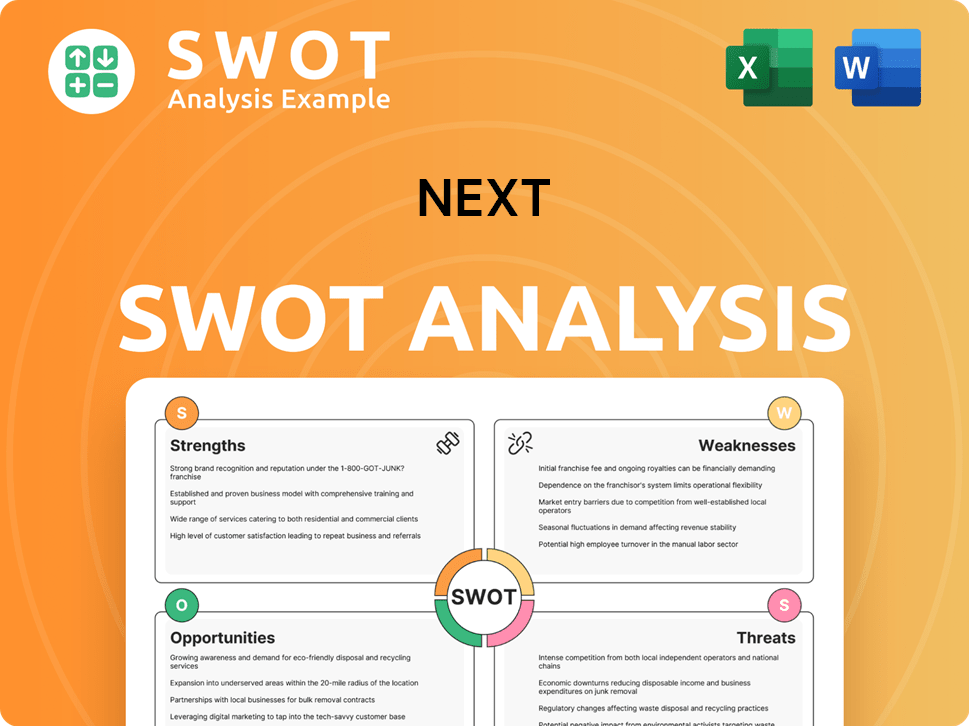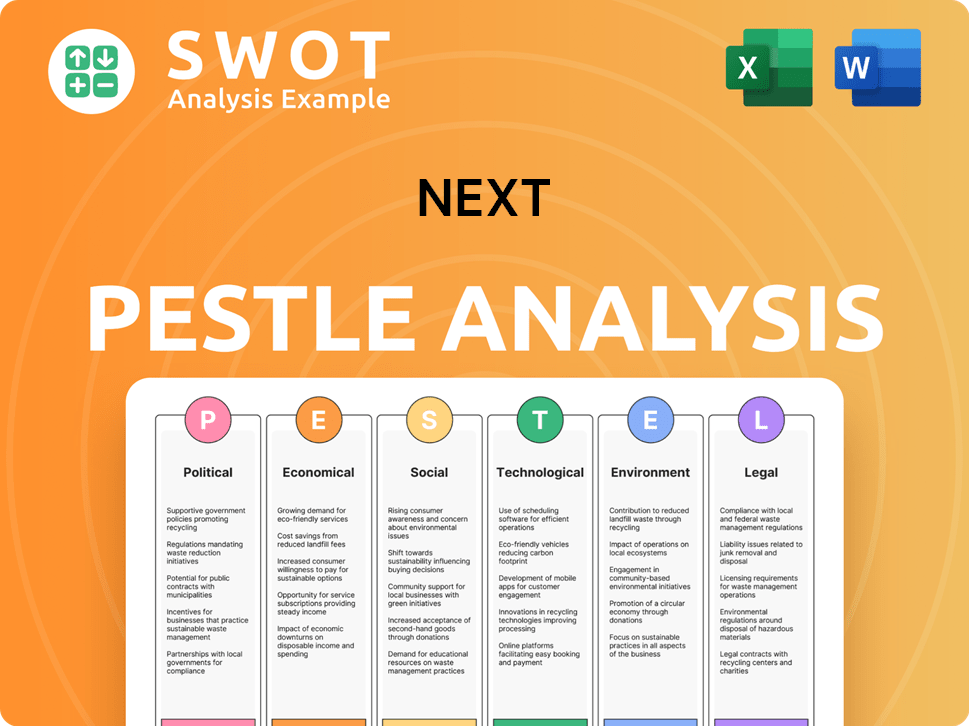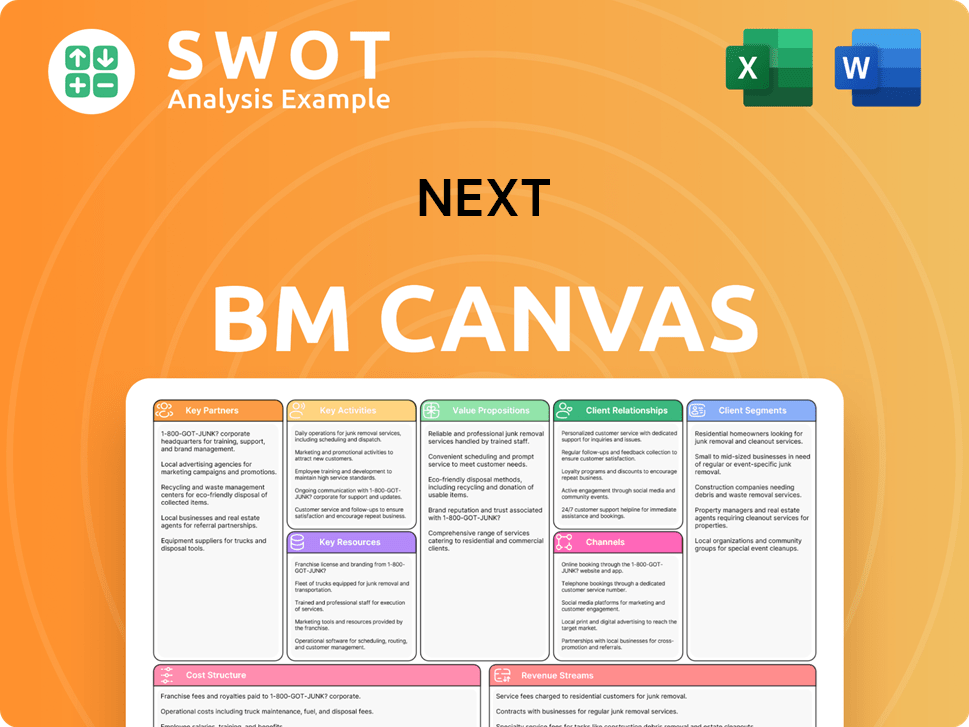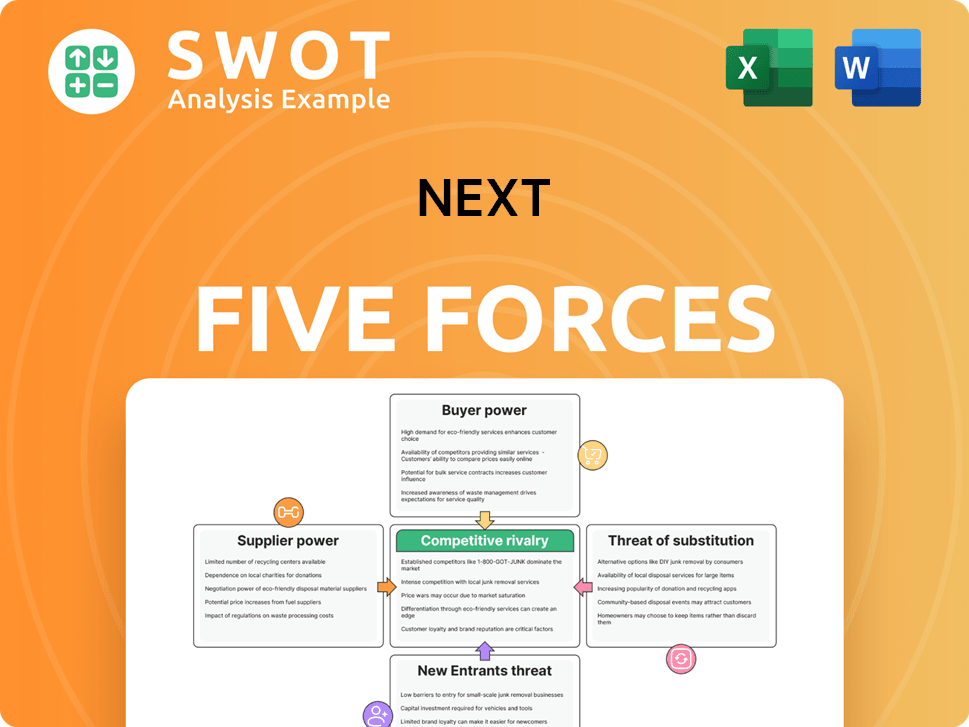Next Bundle
Who Shops at Next? Unveiling the Customer Demographics.
In the ever-evolving world of retail, understanding your customer is paramount. For a retail giant like the Next company, knowing who buys their products is crucial for success. This deep dive explores the customer demographics and target market analysis that drive Next's strategic decisions.

From its origins as a fashion-focused retailer, Next has expanded its reach significantly. This growth necessitates a thorough understanding of its evolving customer base, including their preferences, demographics, and purchasing behaviors. To further understand the company's strategic approach, consider exploring a detailed Next SWOT Analysis.
Who Are Next’s Main Customers?
The primary customer segments for Next plc are diverse, primarily operating within the B2C (business-to-consumer) sector. Initially, the company focused on fashion-conscious individuals, especially women, in the middle to upper-middle-income brackets. These customers sought stylish, accessible clothing. Over time, Next has broadened its reach to include a wider range of age groups and family situations.
Next's product lines, including womenswear, menswear, childrenswear, and home goods, reflect this diversification. For instance, the childrenswear segment appeals to parents and guardians, while home products attract homeowners and those furnishing their living spaces. This approach allows Next to cater to various needs within a household.
In terms of income level, Next generally targets consumers comfortable with spending on quality fashion and home items, often reflecting a mid-market positioning. The company's extensive online presence and catalog business, Next Directory, also enable it to reach customers who may not have easy access to its physical retail stores or prefer home shopping.
Next's customer base is segmented by age, gender, income, and lifestyle. The company's offerings span clothing, home goods, and more, catering to a broad demographic. This diversification allows Next to capture a larger market share and adapt to changing consumer preferences.
Next targets consumers who are willing to spend on quality fashion and home items. This mid-market positioning ensures that the company appeals to a broad audience. The focus on quality and style helps Next maintain customer loyalty and attract new customers.
Next Online saw full-price sales increase by 6.3% in the year to January 2024, indicating the growing importance of the online segment. This growth demonstrates the effectiveness of Next's digital strategy. The online channel provides convenience and accessibility to a wider customer base.
Next's acquisitions, like Joules and Made.com, broaden its appeal to new customer segments. These moves allow Next to expand into the premium lifestyle and home furnishing markets. This strategic approach helps Next stay competitive and cater to evolving consumer demands.
The company's strategic shifts have been prompted by evolving market trends, including the increasing dominance of online retail and the demand for a more holistic lifestyle offering beyond just clothing. The acquisition of brands like Joules and Made.com further illustrates Next's strategy to broaden its appeal and capture new customer segments, particularly in the premium lifestyle and home furnishing markets. This adaptability allows Next to maintain its competitive edge and cater to changing consumer preferences. For more insights, you can read a Brief History of Next.
Next's target market analysis reveals a focus on fashion-conscious consumers across various age groups and income levels. The company's product range caters to diverse needs, from clothing to home goods, ensuring broad appeal. Understanding these customer demographics is crucial for effective marketing strategies.
- Age: Spans various age groups, from young adults to families.
- Income: Middle to upper-middle-income brackets.
- Lifestyle: Fashion-conscious individuals and those seeking quality home products.
- Location: Customers across the UK and internationally, with a strong online presence.
Next SWOT Analysis
- Complete SWOT Breakdown
- Fully Customizable
- Editable in Excel & Word
- Professional Formatting
- Investor-Ready Format

What Do Next’s Customers Want?
Understanding the customer needs and preferences of the [Company Name] is crucial for tailoring products, marketing strategies, and overall business operations. Customer demographics, coupled with a thorough target market analysis, provide essential insights into what drives purchasing decisions and brand loyalty. Analyzing customer demographics data helps in refining the approach to meet and exceed customer expectations.
Customers of [Company Name] are driven by a blend of practical needs, aesthetic preferences, and aspirational goals. They seek a balance of quality, style, and value across clothing, footwear, and home offerings. The company's success hinges on its ability to meet these diverse expectations, whether through in-store experiences or online platforms.
Purchasing behaviors are influenced by convenience, product availability, and the overall shopping experience. The decision-making process often involves brand reputation, product reviews, and the perceived durability and versatility of items. For instance, the ease of browsing a wide selection online, coupled with efficient delivery and returns, is a significant draw for many customers. The Growth Strategy of Next highlights how understanding these preferences is key to their market success.
Customers are motivated by the desire for contemporary style, comfort, and the ability to curate a fashionable wardrobe or home environment without excessive cost. Practical needs include the convenience of consolidated shopping across multiple categories and reliable delivery services. This understanding is critical for target market identification process.
The shopping experience, both online and in-store, significantly influences customer decisions. Factors include ease of browsing, product availability, and efficient delivery and returns. The ideal customer values a seamless and convenient shopping journey.
Fashion items are often purchased for seasonal updates or specific occasions, while home goods represent longer-term investments. This variation requires a flexible product strategy. Analyzing customer demographics data helps tailor product offerings.
Loyalty is built on consistent product quality, reliable customer service, and the appeal of own-brand designs. These elements contribute to customer retention and positive brand perception. Understanding these factors is crucial for building a customer profile for [Company Name].
Customers are often driven by a desire for contemporary style, comfort, and the ability to curate a fashionable wardrobe or home environment without excessive cost. These psychological drivers influence purchasing behaviors. The company's marketing strategy should address these needs.
Practical drivers include the convenience of consolidated shopping across multiple categories and reliable delivery services. Addressing these needs enhances customer satisfaction. The company's logistics and customer service play a crucial role.
The company addresses common pain points by providing curated collections and styling advice. Customer feedback and market trends continually influence product development. The company tailors its marketing through personalized recommendations based on past purchases and browsing history. Understanding customer behavior through demographics is essential for effective marketing strategies.
- Product Development: Expanding eco-conscious ranges to meet the increasing demand for sustainable fashion.
- Marketing Personalization: Offering personalized recommendations based on past purchases and browsing history.
- Product Features: Highlighting specific features, such as durable children's wear or sophisticated home furnishings, to appeal to specific segments.
- Customer Service: Providing reliable delivery services and efficient returns processes to enhance customer satisfaction.
Next PESTLE Analysis
- Covers All 6 PESTLE Categories
- No Research Needed – Save Hours of Work
- Built by Experts, Trusted by Consultants
- Instant Download, Ready to Use
- 100% Editable, Fully Customizable

Where does Next operate?
The geographical market presence of Next is predominantly focused on the United Kingdom. This is where it holds a significant market share and strong brand recognition across its retail stores, online channels, and catalogue business. The UK serves as its core market, with a substantial network of physical stores complemented by a robust online platform. This strategic concentration allows for efficient resource allocation and brand management within a well-established market.
Beyond the UK, Next has a notable international presence, primarily through its online division, Next International. This online strategy enables the company to reach customers in numerous countries worldwide. While physical retail presence outside the UK is more limited, the online platform allows for broader global reach and access to international markets. This dual approach – strong domestic presence coupled with international online sales – is a key aspect of Next's geographical strategy.
Next's approach to international markets involves adapting its online offerings and marketing strategies to suit local tastes and logistical requirements. For instance, its international websites may offer localized currency options and delivery services to enhance the customer experience. Next's international expansion has been strategic, often focusing on regions with strong demand for British fashion and home goods. The company's ability to leverage its online capabilities for global reach has been a key factor in its international success. For a detailed view of the competitive environment, check out the Competitors Landscape of Next.
The UK market is the primary focus for Next, with customer demographics reflecting a broad range of ages, income levels, and lifestyles. The company caters to a wide demographic, offering products that appeal to families, young professionals, and a diverse customer base. Understanding these customer demographics is crucial for effective marketing and product development.
Next International allows the company to reach customers globally, with a focus on online sales. The company adapts its online offerings to suit local tastes and logistical requirements. This strategy is crucial for capturing international customer demographics and preferences.
Next employs market segmentation strategies to target different customer groups effectively. This involves dividing the market into segments based on demographics, lifestyle, and purchasing behavior. This approach helps in tailoring marketing efforts and product offerings to specific customer needs.
Creating customer profiles helps Next understand its target market better. These profiles include details such as age, income, and lifestyle, which inform product development and marketing strategies. This allows the company to identify the ideal customer for its products.
Identifying the ideal customer is a key aspect of Next's strategy. This involves understanding the characteristics and preferences of the most valuable customers. The company uses this information to refine its target market analysis and improve customer satisfaction.
Next International sales grew by 1.6% in the year ending January 2024, demonstrating the importance of the international online segment. The UK remains the primary driver of sales and growth, with international sales contributing significantly to overall revenue. This financial data highlights the effectiveness of Next's geographical market strategy.
Next Business Model Canvas
- Complete 9-Block Business Model Canvas
- Effortlessly Communicate Your Business Strategy
- Investor-Ready BMC Format
- 100% Editable and Customizable
- Clear and Structured Layout

How Does Next Win & Keep Customers?
The following outlines the customer acquisition and retention strategies employed by Next plc. Next strategically utilizes a blend of digital and traditional marketing approaches to attract and retain its customer base. This multi-faceted approach ensures a broad reach and caters to diverse customer preferences.
For customer acquisition, Next leverages digital channels extensively. These include social media advertising, search engine marketing, and email campaigns. Traditional methods, like catalogue mailings, are also still used. Sales tactics include seasonal sales and targeted promotions.
Customer retention is a high priority for Next, with loyalty programs and personalized experiences at the core of its strategy. The Nextpay credit account is an example of a loyalty program. Data analysis and CRM systems are extensively used to deliver tailored marketing messages and product recommendations, enhancing customer experience and increasing engagement. After-sales service, including efficient delivery and a robust returns policy, contributes significantly to customer satisfaction and retention.
Next uses digital advertising across social media platforms and search engine marketing to reach potential customers. These strategies are designed to showcase new collections and promotional offers. This approach is crucial for attracting new customers and driving online sales.
Traditional marketing methods, such as the Next Directory and print media, are still employed, particularly to target the established customer base. These channels help maintain brand visibility and reach demographics that may not be as active online. The company adapts its approach to reach different customer segments effectively.
Next utilizes influencer marketing and affiliate programs to expand its reach and connect with new demographics. These strategies help to increase brand awareness and drive traffic to the website. They are particularly effective in engaging younger audiences and those active on social media.
Sales tactics include seasonal sales events, targeted promotions, and exclusive online offers. These tactics are designed to drive sales and attract customers. These events are strategically timed to capitalize on consumer spending habits and seasonal trends.
Next's strategy emphasizes customer retention through loyalty programs and personalized experiences. The Nextpay credit account offers flexible payment options and early access to sales, fostering repeat purchases. CRM systems leverage customer data to segment the audience and deliver targeted marketing messages. This personalized approach enhances customer experience and increases engagement. After-sales service, including efficient delivery and a robust returns policy, also contributes significantly to customer satisfaction and retention. These initiatives are key to building lasting customer relationships.
The Nextpay credit account is a key component of the loyalty program, offering benefits like flexible payment options and early access to sales. These incentives encourage repeat purchases and help build customer loyalty. This approach ensures customer retention and drives sales.
Next leverages CRM systems to segment its audience and deliver highly targeted marketing messages and product recommendations. This personalized approach enhances the customer experience and increases engagement. Data-driven strategies ensure that customers receive relevant offers.
The continuous improvement of the e-commerce platform and mobile app ensures a seamless shopping experience. This focus on digital channels has been pivotal in Next's acquisition and retention strategies. A user-friendly online presence is crucial for customer satisfaction.
Efficient delivery and a robust returns policy contribute significantly to customer satisfaction and retention. Providing excellent after-sales service ensures that customers have a positive experience. This helps build trust and encourage repeat business.
Next's digital transformation has been pivotal in its acquisition and retention strategies. The company’s focus on online sales, which saw a 6.3% increase in full price sales for Next Online in the year to January 2024, underscores the success of its digital acquisition and retention efforts. This has significantly impacted customer lifetime value.
Strategic changes over time have included a greater emphasis on digital channels and data-driven marketing. These changes have positively impacted customer lifetime value and reduced churn rates by offering more relevant and timely interactions. These changes have improved the customer experience.
Next's customer acquisition and retention strategies are multifaceted, focusing on digital marketing, loyalty programs, and personalized customer experiences. These strategies have yielded positive results, including increased online sales and improved customer lifetime value.
- Digital marketing campaigns drive traffic and sales.
- Loyalty programs foster repeat purchases and customer retention.
- Personalized marketing enhances customer engagement.
- Continuous improvement of the e-commerce platform improves the customer experience.
For further insights into the company's strategic direction, including its growth initiatives, consider reading more about the Growth Strategy of Next.
Next Porter's Five Forces Analysis
- Covers All 5 Competitive Forces in Detail
- Structured for Consultants, Students, and Founders
- 100% Editable in Microsoft Word & Excel
- Instant Digital Download – Use Immediately
- Compatible with Mac & PC – Fully Unlocked

Related Blogs
- What are Mission Vision & Core Values of Next Company?
- What is Competitive Landscape of Next Company?
- What is Growth Strategy and Future Prospects of Next Company?
- How Does Next Company Work?
- What is Sales and Marketing Strategy of Next Company?
- What is Brief History of Next Company?
- Who Owns Next Company?
Disclaimer
All information, articles, and product details provided on this website are for general informational and educational purposes only. We do not claim any ownership over, nor do we intend to infringe upon, any trademarks, copyrights, logos, brand names, or other intellectual property mentioned or depicted on this site. Such intellectual property remains the property of its respective owners, and any references here are made solely for identification or informational purposes, without implying any affiliation, endorsement, or partnership.
We make no representations or warranties, express or implied, regarding the accuracy, completeness, or suitability of any content or products presented. Nothing on this website should be construed as legal, tax, investment, financial, medical, or other professional advice. In addition, no part of this site—including articles or product references—constitutes a solicitation, recommendation, endorsement, advertisement, or offer to buy or sell any securities, franchises, or other financial instruments, particularly in jurisdictions where such activity would be unlawful.
All content is of a general nature and may not address the specific circumstances of any individual or entity. It is not a substitute for professional advice or services. Any actions you take based on the information provided here are strictly at your own risk. You accept full responsibility for any decisions or outcomes arising from your use of this website and agree to release us from any liability in connection with your use of, or reliance upon, the content or products found herein.